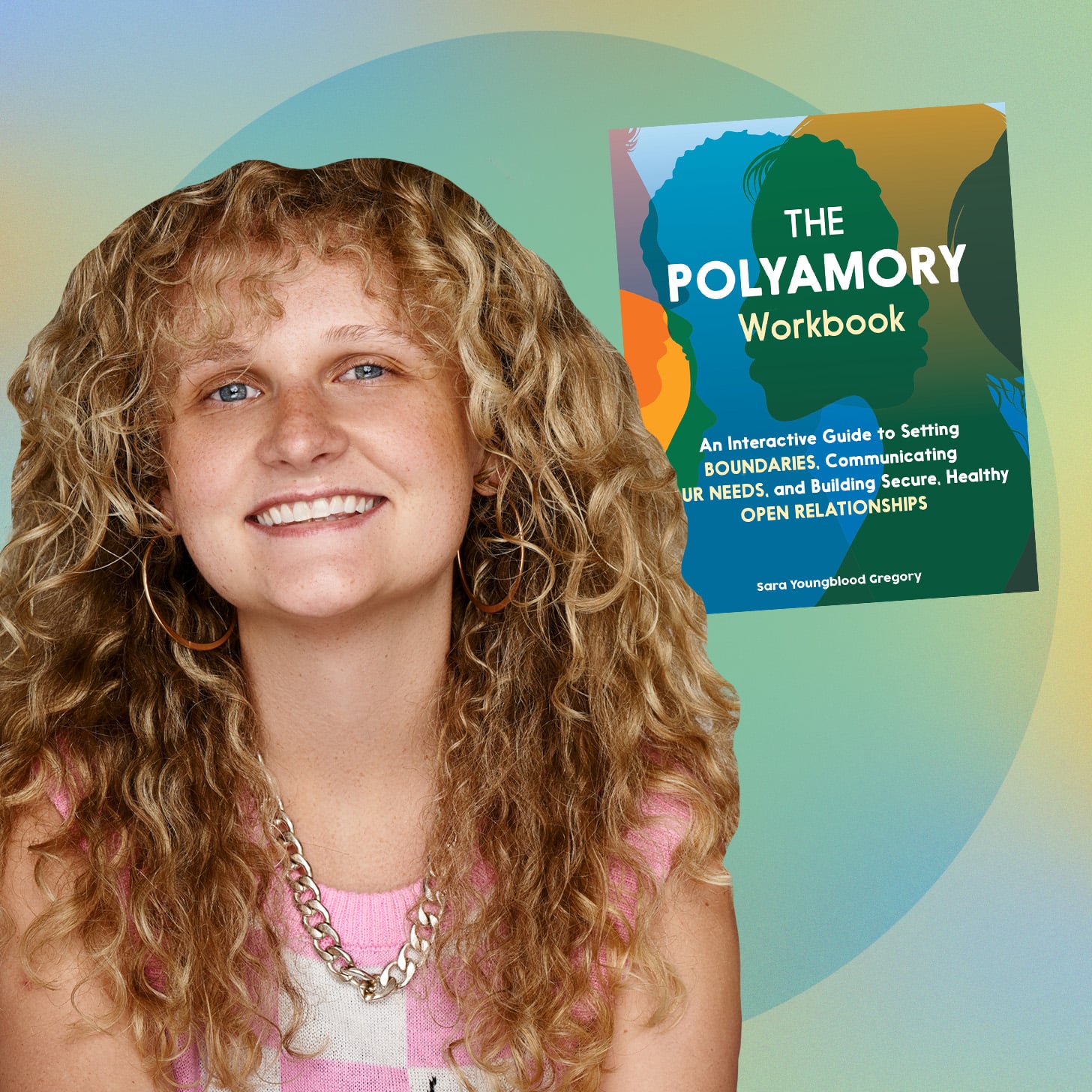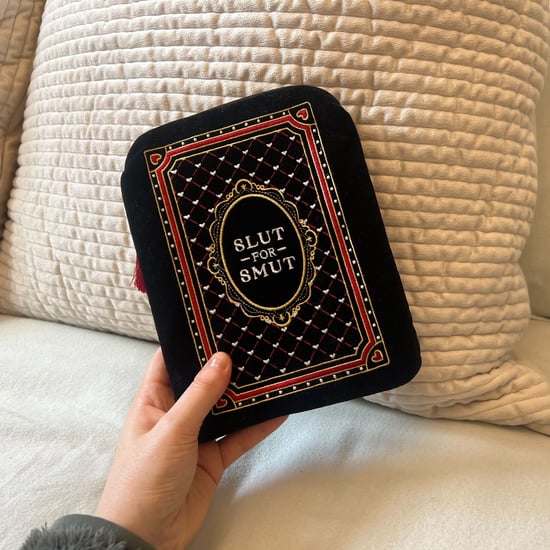Explore Non-Monogamy With "The Polyamory Workbook"
What If We Start Loving Like It’s Infinite? An Interview With a Relationship Anarchist
As POPSUGAR editors, we independently select and write about stuff we love and think you'll like too. If you buy a product we have recommended, we may receive affiliate commission, which in turn supports our work.

Nonmonogamy has existed for as long as the concept of love. Yet, the term "polyamory" has only recently entered the zeitgeist — from polyamorous educators going viral on TikTok to HGTV broadcasting a throuple on their journey to purchase a home together. And few books discuss — let alone guide people through — the experience. This is why Sara Youngblood Gregory's new book, "The Polyamory Workbook" ($17), published Nov. 15, couldn't have arrived at a more perfect time.
Youngblood Gregory is a lesbian writer who has made a career of filling the gaps in our collective lack of sex education. As a queer person, they were drawn to "relationship anarchy" at a young age. Although you do not need to identify as queer to participate in polyamory, the practice of polyamory is inherently queer: It pushes back against what we were taught about how love works. Instead of searching for "the one," polyamory asks what could happen if you believed love isn't a scarce resource but something that can be shared freely. And as a queer writer, I am endlessly fascinated by the many ways our community can love. Not in the "love is love" cliché that you might see pasted onto Target t-shirts during Pride month, but in how we formed a new mindset after centuries of living and loving outside the lines.
"I hope after reading, people will know themselves better. Knowing yourself — your desires, your goals, your values, your triggers and tendencies — is really powerful."
But sometimes, living outside of the lines can be confusing and scary without guidance. That's why Youngblood Gregory's book offers a glossary for standard terms within the community as well as prompts that help you practice setting boundaries, communicating needs, and building secure, healthy relationships. It's also filled with expert advice and personal experiences from educators like Sam, the founder of the educational platform Shrimp Teeth, and Crystal Byrd Farmer of Black and Poly, on the topic of navigating communication styles, consent, and accountability. "The Polyamory Workbook" read more to me like a self-help book without the gimmicks and with all of the tangible (literally interactive) advice you need to reframe how you view love in your life (romantic and platonic).
"I knew from the beginning that I wanted a book full of voices, so one of the first things I did was reach out to a few wonderful educators and thinkers in the non-monogamous community," Youngblood Gregory tells POPSUGAR. "I also invited in my own loved ones to join me for a conversation so folks could see how a network of lovers — often called a 'polycule' — reflects on their own experiences." Ultimately, Youngblood Gregory says it was vital for them to offer multiple perspectives on non-monogamy, not just their own. "Because in real life, you will constantly have to reconcile your expectations with those around you."
I've had the pleasure of working alongside Youngblood Gregory at POPSUGAR, so when I had the opportunity to chat with them about writing the workbook, I was eager to ask about how anyone — regardless of their chosen relationship style — can take the first steps to embrace loving freely. Below is what transpired between us.
POPSUGAR: How did this workbook come to be? Was it always going to be a workbook or did it morph into one after you started writing it?
Sara Youngblood Gregory: "The Polyamory Workbook" was one of those projects that knocked on my door at just the right time. I'd been writing about relationships, polyamory, sex, and identity for a while in my capacity as a journalist and essayist, but had never really considered doing any sort of long-form project on those topics. Meanwhile, I'd been in touch with a wonderful editor at Ulysses Press, Kierra Sondereker, and a few months later she reached out to gauge my interest in doing a workbook on non-monogamy. So, the project was always meant to be an interactive, guided workbook people could do by themselves or with loved ones. The concept of a workbook is really appealed to me — relationships are interactive, constructive, and require conversation. I love that "The Polyamory Workbook" offers the same.
PS: You write that there isn't one definition of polyamory, but if you had to define it, what does it mean to you?
SYG: Simply put, polyamory is an umbrella term used to describe non-monogamous relationships. There are a ton of different styles of non-monogamy out there — including relationship anarchy, open relationships, "Don't Ask, Don't Tell," swinging, hierarchical dynamics, kitchen table polyamory, group dating — and I touch on all of those in the book and define them.
But more than anything, I really dug into a mix of relationship anarchy and kitchen table polyamory, which I believe is most conducive to happy, communicative non-monogamy. The organising principles for my book were freedom and control. Freedom does not mean a free-for-all; it means realistic expectations, healthy boundaries, and turning away from what I consider the pitfalls of all relationships (not just non-monogamous ones): rule-setting, controlling behaviour, and a lack of meaningful accountability.
PS: Is there ever really an "ideal" time to enter into polyamory in order to minimize the risk of hurting yourself and others?
SYG: The ideal time looks different for everyone and every relationship. Some people come into non-monogamy as a single person looking to date multiple people. Others fall for someone who is already polyam and is introduced via proximity and circumstance. There are also monogamous couples who want to explore dating outside of their relationship. These are all great opportunities to enter into polyamory.
But like with any new experience or big change, it helps to lay the groundwork beforehand. This can look like reading, educating yourself on common relationship dynamics, and seeing a polyam therapist or couple's counselor to open channels of communication and have a safe, professional neutral party to assist the transition. And of course, folks need to take safe sex extremely seriously.
If you're single and entering polyamory, it helps to know what your core values are. Do you want to interact with your lover's lovers? Are you looking to settle down and cohabitate with one person, or potentially more? What about finances? How do you handle conflict? What's your plan to navigate the hard feelings that will arise? Do you have a solid support system? These are all great questions to ask yourself before jumping in — but also some of your answers will probably change as you experience new things and meet new people. That's great, too.
For couples, it can be more challenging because you've existed in a certain rhythm, and now that rhythm is changing. Asking yourself the same questions helps to articulate your different desires and goals for non-monogamy, but it's also a good idea to take things slow. When you open up a monogamous relationship, your responsibility isn't just to each other. You both share a responsibility to whoever you bring into the relationship — whether you're solo dating or dating as a couple — to treat them well and be forthcoming about your newness to this kind of relationship.
All that said, prepping for polyamory and actually doing it are two different things. It takes time, patience, and a lot of adjusting and rewiring before you get your feet under you. And that's OK!
PS: Really, a lot of this workbook focuses on doing the work yourself and not expecting others (partners, etc.) to "fix" you. This feels so opposite of what we've been raised to believe — that your partner will complete you. I'd love to hear your thoughts on how these two truths can exist at once: love can be unconditional (or infinite, as you write) but love can also have boundaries.
SYG: That's absolutely it — making the switch to a polyamorous mindset means we have to confront the messages about love and relationships many people have been taught from a young age. For example, the ideas that other people will "complete" you or "fix" you, that loyalty requires exclusive sex, that love can only be given to one person, and on and on. These aren't just ideas that hurt polyamorous people, but they also hurt monogamous people. Love isn't a scarce resource. We all need multiple friends, family figures, and loved ones with which we can share different passions, interests, etc. There's a whole tapestry of social connections people need to feel a sense of community. For many people, having multiple romantic connections is a demonstration that there's enough love to go around and their lovers are a big part of how they shape their community.
But of course, love needs healthy boundaries. Not rules or control, but boundaries for sure. Boundaries around love communicate your non-negotiable values, set expectations, and allow you to feel safe in a relationship. A great example? "I am happy to treat you on dates and spend money on this relationship, but I will not merge finances."
PS: While I agree that we live in a predominantly sex-negative culture, we're also seeing more people consider and embrace ethical non-monogamy (or at least, acknowledge it). While polyamory becomes more normalized, what do you wish more people would know that's still often misconstrued?
SYG: Polyamory is a long haul. It takes a lot of internal work, negotiation, and reflection to get to a place of ease and comfort — but that's how it is in any relationship. I find a lot of comfort and solidarity in knowing that I'm not alone in figuring out how to show up for my loved ones, take care of myself, and build loving, healthy relationships. Everyone is in that same boat, across all relationship styles.
PS: What's the first step someone should take if they're considering polyamory? (Besides buying this workbook, of course!)
SYG: Investigate what attracts you to polyamory and what motivates your potential exploration. It's a decision you have to make for yourself and you have to want it for yourself — not because it seems fun or trendy, not because your partner is pushing you to try it out, and not because everyone else around you is doing it. The curiosity and interest should be coming from you, and knowing firmly what draws you to non-monogamy will help you make the best decisions for yourself.
PS: What's the most important thing you hope readers will take away from completing your workbook?
SYG: I hope after reading this, people will know themselves better. Knowing yourself — your desires, your goals, your values, your triggers, and tendencies — is really powerful.






